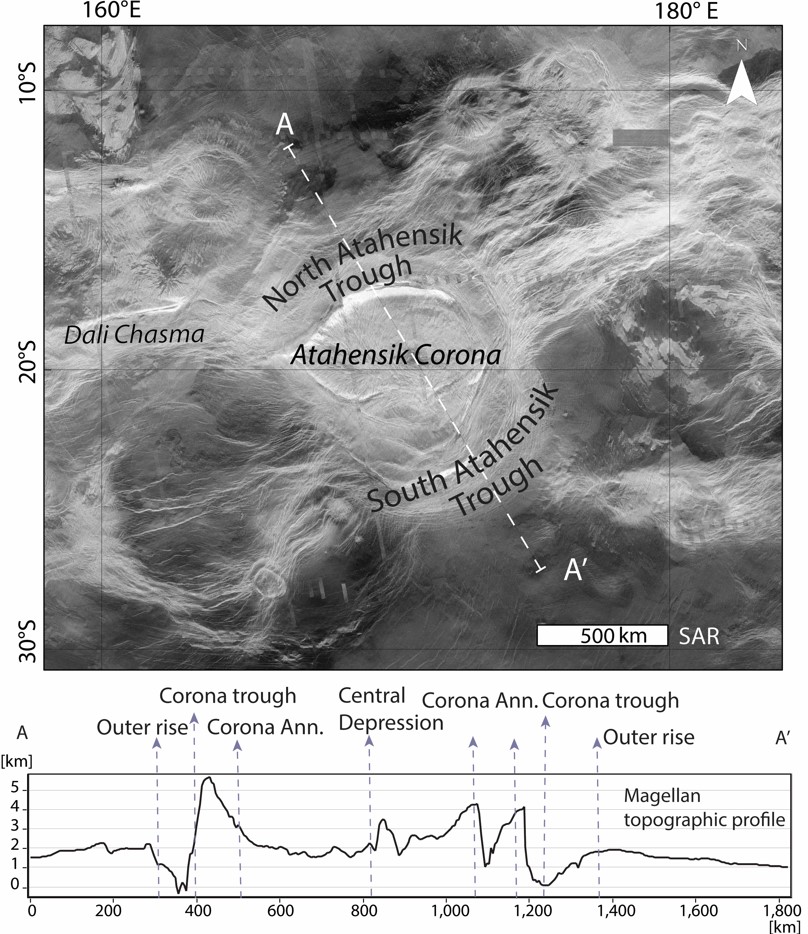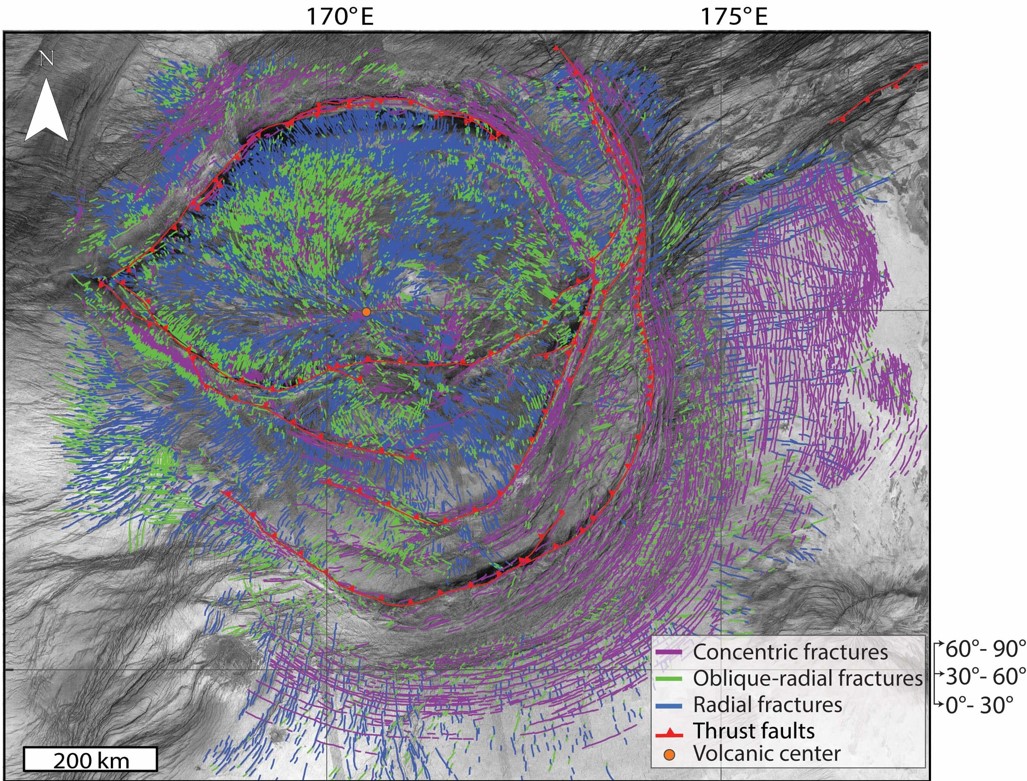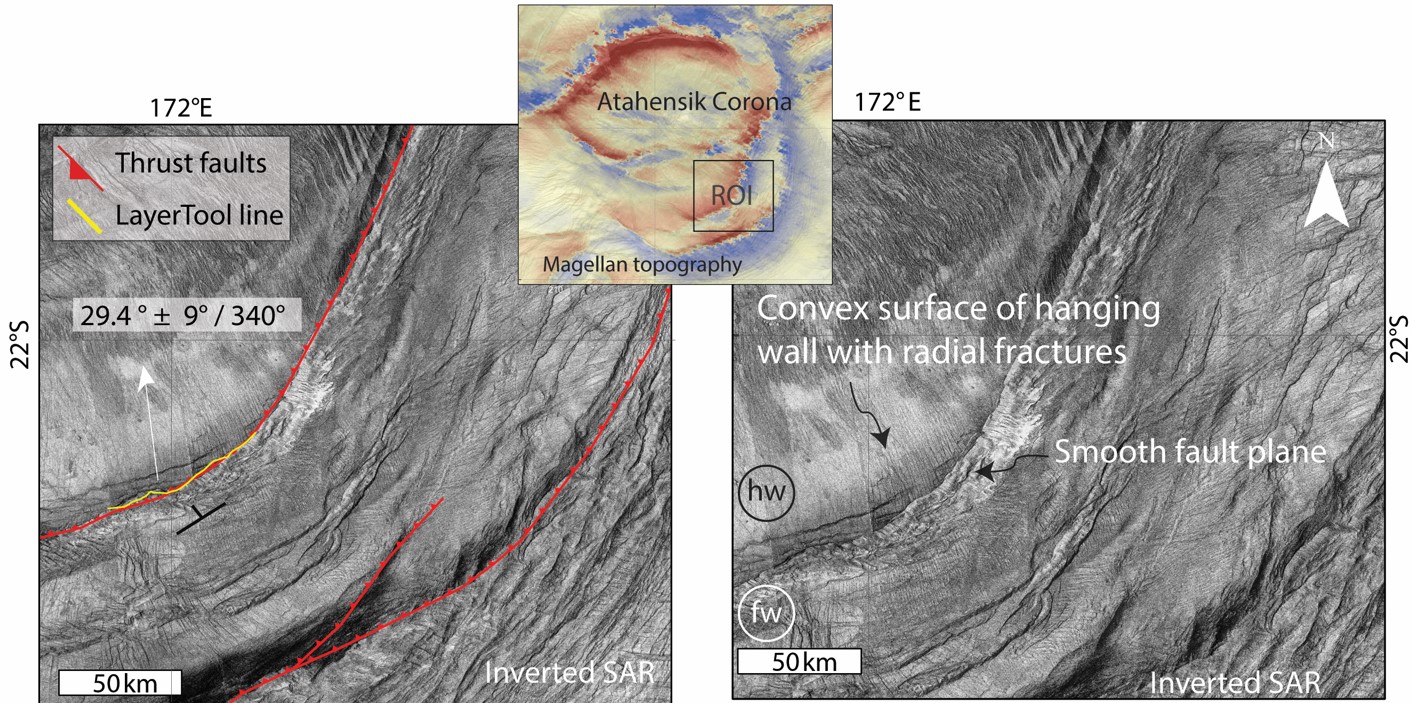Low-angle faults at the rim of a large Venusian corona
- University of Freiburg, Institute of Earth and Environmental Sciences, Geology, Freiburg, Germany (thomas.kenkmann@geologie.uni-freiburg.de)
Abstract
We analyzed the structure of Atahensik Corona (700 x 900 km) of eastern Aphrodite Terra on Venus. This corona contains a high density of radial, oblique, and concentric fractures and is surrounded by arcuate troughs. The high density of concentric fractures along the outer rise indicates elastic down-bending of the corona´s surrounding. The deep, asymmetrical, and arc-shaped troughs are expressions of incipient subduction and expose large-scale fault zones along their steep inner slopes that trend parallel to the trough axes. The exposed faults are several hundred kilometers long and dip gently towards the corona center. The faults have a multi-stage history. They were initiated as thrusts but became reactivated as low-angle normal faults and then exposed parts of their fault surfaces. The multi-stage activation is in agreement with current models of corona formation. Plume uplift and topographic uplift of the corona interior are indicated by early radial fracturing. Subsequent lateral spreading of the plume steepened the outer rim and caused a fractured ridge annulus to form. Overthrusting in the corona periphery may have started in the immediate surrounding of a negatively buoyant, delaminated lithosphere, where the lithosphere was intact and cooler. Reactivation of the thrusts as low-angle normal faults resulted from subsidence of the corona´s interior as a consequence of decreased activity and cooling, and subsequent gravitational instability of the elevated corona annulus.
Introduction
Coronae are unique volcano-tectonic features on Venus that transport heat from the mantle to the surface. Large coronae are roughly circular to ovoid, contain a fractured ridge annulus, and are surrounded by arcuate troughs and outer rises [1-2]. The central regions of coronae may contain volcanic edifices [3]. The majority of geodynamic models of corona formation postulate a buoyant magma diapir that rises through the mantle [3-5] followed by a lateral spreading of the plume. Other models suggest that coronae result from Rayleigh–Taylor instability of the mantle [6] or by magmatic loading of the crust.

Fig.1 Magellan SAR image (left looking) of Atahensik Corona and NW-SE topographic profile across the structure.
Data and Methods
We used NASA´s Magellan synthetic aperture radar (SAR) global mosaics, which have a spatial resolution of ∼75 m per pixel in this region [7], and DEM that is based on a combination of Magellan global topography data records and a stereo imagery cross-correlation of SAR data [8]. For mapping of radar images using ArcGIS 10.7, we have adopted a black-and-white inversion approach for the SAR data. Measurements of strike and dip of faults were carried out with the LayerTools plugin for ArcGIS [9].
Results and Interpretation
Atahensik is one of the largest coronae on Venus (Fig.1). It has an asymmetric, eye-shaped form and comprises several asymmetric and arc-shaped troughs. The convex sides of the troughs are flanked by broad and gentle outer rises. The troughs have asymmetric topographic profiles (Fig.1) with a gentle outer slope and a steep inner slope that merge into the Atahensik´s annulus ridge. The central region of Atahensik Corona is morphologically depressed (Fig.1).

Fig.2 Fractures and major faults of Atahensik. The orientation of fractures relates to Atahensik´s center.
Atahensik Corona has a high density of fractures (Fig.2). A detailed analysis of crosscutting relationships between the fracture systems indicates that radial fractures in most cases developed first, followed by oblique, and finally concentric fractures. The inner slopes of the arcuate troughs show abrupt changes in SAR reflectivity (Fig.3) and major fault traces parallel to the trough axes were detected. Radial fractures do not continue from the convexly shaped hanging wall to the footwall of the faults. The faults strike concentrically and gently dip to the corona center. The smooth fault planes are partly exposed and form terraces in the slope profiles. This can only occur in a normal faulting regime when the hanging wall is displaced and exposes parts of the fault plane. The observation that the faults are low-angle normal faults is in contrast to the trough asymmetry, the presence of an outer rise, and the fracture pattern that all indicate lithospheric bending associated with overthrusting and incipient subduction (Fig.1). The apparent contradiction is resolved when a reactivation of the fault with the opposite shear sense is assumed. We propose that the faults were initially formed as thrusts during incipient subduction with a typical dip of ~30° towards the corona but were reactivated as a low-angle normal faults, thereby exposing their fault planes. A fault reactivation is expected when the horizontal compressive stresses radial to the corona, e.g. by down-welling decrease and the topographically high ridge annuli forming the rim of Atahensik Corona become gravitationally unstable in a phase of declining magmatic activity. The multi-stage activation agrees with the evolutionary sequence proposed for corona formation. Fault reactivation is a well-known phenomenon on Earth and low-angle normal faults are widely recognized [10]. The reactivation of a thrust fault as a low-angle normal fault requires a significantly reduced friction coefficient. On Earth, this is achieved by the presence of ductile shear zones, phyllosilicates, or a fluid overpressure. In the absence of hydrous phases and fluids on Venus, a decrease in fault strength and friction coefficient might be achieved by abrasive smear of rocks associated with thermally activated crystal plasticity or the lubrication of the fault plane by a melt film, possibly of a frictional origin.

Fig.3 Inverted SAR of the SE Atahensik trough with tectonic labels, LayerTool line, and the average dip angle and dip azimuth of the major fault.
References:
[1] Smrekar, S.E., Stofan, E.R., 1997, Science 277, 1289-1294. [2] Sabbeth, L. et al. 2024, EPSL, 633, 118568. [3] Squyres, S.W. et al., 1992, JGR 97, 13611–13634. [4] Gülcher, A.J. et al., 2020, Nature Geoscience, 13(8), 547-554. [5] Hoogenboom, T. & Houseman, G.A., 2006, Icarus, 180, 292-307. [6] Tucker, W.S. & Dombard, A.J., 2023, JGR, 128, e2023JE007971. [7] Pettengill, G.H., et al., 1991, Science, 252, 260-265. [8] Herrick, R.R. et al. 2012, EOS, 93, 125–126. [9] Kneissl, T., et al., 2010, LPSC, 41, #1640. [10] Wernicke, B., 1995, JGR 100, 20159-20174.
How to cite: Kenkmann, T. and Karagoz, O.: Low-angle faults at the rim of a large Venusian corona, Europlanet Science Congress 2024, Berlin, Germany, 8–13 Sep 2024, EPSC2024-383, https://doi.org/10.5194/epsc2024-383, 2024.